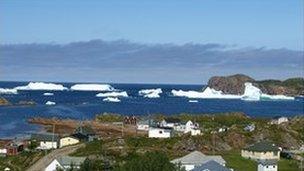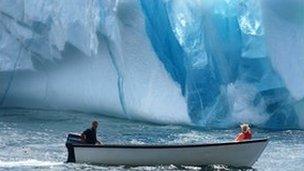World iceberg capital turns frozen blocks to cold, hard cash
- Published
How Twillingate is cashing in on its icy visitors
Twillingate is obsessed with icebergs. The eastern Canadian fishing town calls itself the iceberg capital of the world, and tourists flock to visit in the summer when the season for the frozen goliaths is booming.
Many in the community off the north-eastern shore of Canada's Newfoundland and Labrador province make their living from the icebergs.
"We all love to see when the icebergs are here," says Capt Perry Young.
The iceberg tourism works its way into "every aspect of business in Twillingate", from accommodation to restaurants to convenience stores, he says.
And when the icebergs fail to drift into the region, which happened as recently as two years ago, it places a lot of pressure on the town.
"It puts a strain on us financially because, I mean, it's pretty much 50% of our income," Mr Young says.
"And when you lose 50% of your income it hurts," he adds.
Peak iceberg season is May and June, though this year was a relatively good one, and the mammoth frozen blocks were still floating by as late as August.
'Iceberg alley'
Twillingate's traditional saltbox houses, fishing boats and docks make it look like something from a postcard.

The fishing village of Twillingate has a population of about 2,500 residents
About 2,500 people live in Twillingate but when an iceberg rolls in, those numbers rise dramatically.
"We are actually right beneath the iceberg alley, which is the Labrador Current," says Kim Young, who operates tourist boat tours in the town.
"So when the current comes out through the alley they bring them to us," Ms Young adds.
Drawing in tourists is important business in Twillingate.
Like many fishing villages in Newfoundland and Labrador, residents of Twillingate suffered when they lost their cod-fishing industry, which was shut down by the Canadian government in 2003 because of declining stock.
The residents have had to find another way to make a living, and attracting tourists with icebergs was the answer.
Tracking icebergs
Now the local tourism board has launched a new pilot programme using GPS tracking devices that allow locals to track icebergs when they are spotted.

There are also three different websites dedicated to showing where icebergs are in the area.
A small group of local fishermen have also started harvesting iceberg water to make iceberg vodka, beer and wine for sale in the province.
"The thing about Newfoundland is that we have to adapt and change with the times, and this is the reason we have been able to survive on this rock for 500 years," says local fisherman David Boyd, the owner of the Prime Berth store, which caters to tourists.
"Human beings have the ability to basically destroy everything that they touch, and we have done that with the fishery, with technology and with very poor management," he adds.
"So we have to adapt and now we are basically capitalising on something that at one time we didn't want to see," Mr Boyd says.
For centuries icebergs were not a welcome sight for residents of Twillingate and local fishermen. Their attraction is a recent phenomenon.
Invading giants
"The icebergs were the scourge of the fishery," says Mr Boyd.
"The fishermen hated to see the icebergs because the big bergs would come in on their nets and their cod traps."
These "invading giants", as locals describe them, come with their own myths and are making their way into local folklore, art and writing.
Visitors can hear stories of murder on an iceberg or the deaths of young local children who have played around them.
"There are all sorts of stories around the province of narrow escapes from them because they are unpredictable," says Twillingate artist Gilbert Manuel.
"Around here and everywhere in Newfoundland, we have a healthy respect for them. We don't go near them - unless you know what you're doing - because they can tip over or founder, break apart, without any warning."
WW2 plane
It isn't just the icebergs themselves that are full of mystery: sometimes it's the visitors that they bring along with them to shore.
One time it was a polar bear, which is extremely rare for the area.
The animal's body is now on display in the town's local museum. Sometimes the icebergs bring treasures from the past.
An aircraft, embedded into an iceberg, also once came drifting into the region, Mr Manuel says.
"Somebody researched it and this was a plane that had crashed I think years ago during the Second World War in Greenland," he says.
This dependence on icebergs can become a burden when they don't drift in.
"I've seen it, a lot of hurtful faces, and I try to explain to them basically, that we are an iceberg viewing area," says Cecil Stockley, a founder of the tourism industry, who is known locally as the Iceberg Man.

Fewer and fewer icebergs are drifting into Twillingate each year
The unpredictable nature of icebergs have added to their allure and have started debates in the town.
Some residents believe climate change is the reason the cold goliaths aren't making it into the area as often.
Others think that this is just part of a natural cycle.
"I believe it is the El Nino effect of warmer water moving north, icebergs are meeting these waters more farther north and melting," says Mr Stockley.
"Even on our best of years, it's hard to get a small percentage of icebergs down here. Even we might get a couple hundred, probably, there is 2,000 in Greenland," adds Mr Stockley.
But Mr Manuel disagrees: "There's fewer of them right now, but it was always like that. You had years when there were icebergs everywhere. Then for whatever reason you have years when there are no icebergs."
The residents of Twillingate will no doubt adapt no matter what happens.